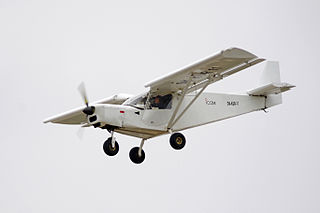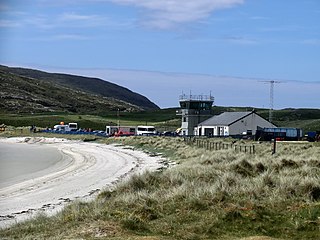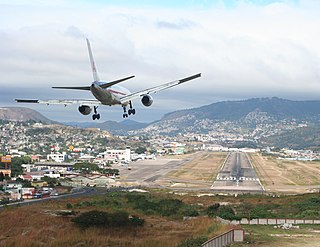
Air traffic control (ATC) is a service provided by ground-based air traffic controllers who direct aircraft on the ground and through a given section of controlled airspace, and can provide advisory services to aircraft in non-controlled airspace. The primary purpose of ATC worldwide is to prevent collisions, organize and expedite the flow of air traffic, and provide information and other support for pilots.

According to the International Civil Aviation Organization (ICAO), a runway is a "defined rectangular area on a land aerodrome prepared for the landing and takeoff of aircraft". Runways may be a human-made surface or a natural surface. Runways, taxiways and ramps, are sometimes referred to as "tarmac", though very few runways are built using tarmac. Takeoff and landing areas defined on the surface of water for seaplanes are generally referred to as waterways. Runway lengths are now commonly given in meters worldwide, except in North America where feet are commonly used.

A short takeoff and landing (STOL) aircraft is a conventional fixed-wing aircraft that has short runway requirements for takeoff and landing. Many STOL-designed aircraft also feature various arrangements for use on airstrips with harsh conditions. STOL aircraft, including those used in scheduled passenger airline operations, have also been operated from STOLport airfields which feature short runways.

In aviation, the instrument landing system (ILS) is a precision radio navigation system that provides short-range guidance to aircraft to allow them to approach a runway at night or in bad weather. In its original form, it allows an aircraft to approach until it is 200 feet (61 m) over the ground, within a 1⁄2 mile (800 m) of the runway. At that point the runway should be visible to the pilot; if it is not, they perform a missed approach. Bringing the aircraft this close to the runway dramatically increases the range of weather conditions in which a safe landing can be made. Other versions of the system, or "categories", have further reduced the minimum altitudes, runway visual ranges (RVRs), and transmitter and monitoring configurations designed depending on the normal expected weather patterns and airport safety requirements.

A heliport, sometimes termed a vertiport, is a small airport suitable for use by helicopters and various types of vertical lift aircraft. Designated heliports typically contain one or more touchdown and liftoff areas and may also have limited facilities such as fuel or hangars. In some larger towns and cities, customs facilities may also be available.

An airfield traffic pattern is a standard path followed by aircraft when taking off or landing while maintaining visual contact with the airfield.
Aviation is the design, development, production, operation, and use of aircraft, especially heavier-than-air aircraft. Articles related to aviation include:

An aerodrome or airdrome is a location from which aircraft flight operations take place, regardless of whether they involve air cargo, passengers, or neither, and regardless of whether it is for public or private use. Aerodromes include small general aviation airfields, large commercial airports, and military air bases.
The visual approach slope indicator (VASI) is a system of lights on the side of an airport runway threshold that provides visual descent guidance information during final approach. These lights may be visible from up to 8 kilometres (5.0 mi) during the day and up to 32 kilometres (20 mi) or more at night.

A precision approach path indicator (PAPI) is a system of lights on the side of an airport runway threshold that provides visual descent guidance information during final approach. It is generally located on the left-hand side of the runway approximately 300 meters beyond the landing threshold of the runway.

Barra Airport is a short-runway airport situated in the wide shallow bay of Traigh Mhòr at the northern tip of the island of Barra in the Outer Hebrides, Scotland. The airport is unique, believed to be the only one in the world where scheduled flights use a tidal beach as the runway. The airport is operated by Highlands and Islands Airports Limited, which owns most of the regional airports in mainland Scotland and the outlying islands. Barra Airport opened in 1936. The airport's only destination is Glasgow.
A maneuvering area is that part of an aerodrome to be used by aircraft for takeoff, landing, and taxiing, excluding aprons and areas designed for maintenance of an aircraft.

London Elstree Aerodrome is an operational general aviation aerodrome located in Elstree, and is situated 2.6 nautical miles east of Watford, Hertfordshire, England.
A STOLport or STOLPORT was an airport designed with STOL operations in mind, usually for an aircraft class of a certain weight and size. The term "STOLport" did not appear to be in common usage as of 2008, although was commonly used by pilots flying into Biggin Hill during 1986/87 when the London City Airport was opened restricting approaches and ceilings to the north of Biggin. A STOLport usually has a short single runway, generally shorter than 1,500 m (5,000 ft). STOLports are only practicable by certain types of aircraft, especially smaller propeller aircraft, with performances that are compatible with the shorter runway length, steeper approach/departure paths, etc. at individual STOLports. In the United States, short runway facilities are simply known as airports, and the term "STOLport" has not been commonly used since the early 1970s.

In aeronautics, the final approach is the last leg in an aircraft's approach to landing, when the aircraft is lined up with the runway and descending for landing. In aviation radio terminology, it is often shortened to "final".

Mustique Airport is a private airfield owned by the Mustique Company for public use and is located on Mustique island, part of Saint Vincent and the Grenadines in the Caribbean Sea. It is used by civil aviation and national airlines using turboprop planes.

In aviation, V-speeds are standard terms used to define airspeeds important or useful to the operation of all aircraft. These speeds are derived from data obtained by aircraft designers and manufacturers during flight testing for aircraft type-certification. Using them is considered a best practice to maximize aviation safety, aircraft performance, or both.

Courchevel Altiport is an altiport serving Courchevel, a ski resort in the French Alps. The airfield has a very short runway of only 537 metres (1,762 ft) with a gradient of 18.6%. There is no go-around procedure for landings at Courchevel due to the surrounding mountainous terrain. The airfield primarily sees use by smaller fixed-wing aircraft such as the Cessna 208 Caravan or Pilatus PC-12, as well as helicopters. The runway has no instrument approach procedure or lighting aids, making landing in fog or low clouds unsafe and almost impossible.

Méribel Altiport, is an altiport in Les Allues, a commune in Savoie, France.

Union Island Airport is the airport serving Union Island, Grenadines Parish, Saint Vincent and the Grenadines. It is located about 0.25 miles (0.40 km) from the town of Clifton, one of the country's main tourist centers and a major destination for charter leisure flights during the winter holiday season and Easter, for "Easterval" celebration. The airport serves as a focus city for flag carrier SVG Air and features flights to several short-haul regional destinations. It is the southmost airport of St. Vincent and the Grenadines.
















